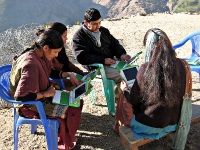Resumen en español al final del artículo
Today there's a fairly broad consensus among researchers, policy makers, and practitioners that support and training of teachers is one of the key components of successful educational technology initiatives. However in many ways that's where the consensus stops because when it comes to how such support and training is structured, what it should and shouldn't focus on, and how much of it should be provided opinions and approaches differ significantly.
With these thoughts in the back of my mind I recently read the March/April edition of OLE Nepal's bi-monthly newsletter and encountered the following section which nicely sums up the organization's approach to teacher training:
The training program combined presentations, interactions, hands-on activities, and practice teaching to prepare teachers to successfully conduct ICT-integrated classes. Training teachers on how to use E-Paath activities, and how they can be integrated in regular teaching were the main focus of the training. Various activities were conducted to make the teachers feel comfortable and confident in using E-Paath to teach various subjects.
The training program also covered topics such as lesson planning, basic troubleshooting, classroom arrangement, techniques for managing the class, and pre and post non-computer activities that can be used to integrate the computer-based activities more effectively.
The training also emphasized the use of digital library E-Pustakalaya and how its content can be used to benefit teachers, students well as the community. Various sections of E-Pustakalaya were briefed and showed to the teachers.
I've often been impressed with OLE Nepal's work in what is surely one of the most challenging environments imaginable for any educational technology project. And while what they're doing might not always be directly applicable for other contexts and projects I do believe that much can be learned from their approach to teacher training.
To learn more about their teacher training efforts head over to the corresponding section on OLE Nepal's Web site.
Resumen en español: Muchas veces me he quedado impresionado con el trabajo de OLE Nepal en lo que es sin duda uno de los entornos más difíciles imaginables para cualquier proyecto de tecnología educativa. Y si bien lo que están haciendo no siempre puede ser directamente aplicable a otros contextos y proyectos sí creo que se puede aprender mucho de su enfoque en cuanto a la formación de maestros. Más información acerca de sus esfuerzos en esta area esta disponible en la sección correspondiente de su pagina Web.



cf. 1. Initial Training
Eight day long residential training
Held right before program is launched at schools
2. In-School Training
Four to six weeks after program launch
Held after students have had ample practice using digital tools. (not mentioned how many days/hours is this training)
3. Refresher Training
Six months after program launch (not mentioned how many days/hours is this training)
I find it amazing people understand computers that fast without a virtual assistant.